|
Radon Supplies
Consulting Services
As a California Certified Radon Mitigation Service Provider, I offer consulting services to home owners and builders to help them come up with the best approach for their specific radon mitigation problem. Contact me for details. (I am not a contractor and do not perform radon installations. See the Connections Page for Certified Radon Mitigation contractors).
Supplies
Aside from the continuous radon tester and do-it-yourself radon book which I sell, I am often asked where to get radon supplies to fix a radon problem, or to build radon out during new construction. Most plumbing supplies, such as 4" PVC pipe, or perforated "french drain" pipe, can be purchased locally. However other pieces of the radon installation are best purchased from a radon supply house. Advice from folks who are knowledgeable about radon installations can be invaluable for the homeowner or building professional who has not experienced various installations, more than worth the shipping expense from Colorado Springs, Colorado. The internet offers many ways to search for and evaluate radon suppliers, but as a convenience to my viewers and customers, I offer my preference here as just that, my preference. Doing business with anyone requires the buyer to beware and do his or her own research. However, that said, I like and support these folks:
1. Radon Control Inc.

Please tell them Radon At Tahoe sent you!
2. PDS Professional Discount Supply
(719) 444-0646
http://www.radonpds.com
Since 1996 in Colorado Springs, Colorado
Contact PDS for current pricing and other system recommendations.
And be sure to tell these suppliers that you were one of  people people
who saw them on Radon At Tahoe.
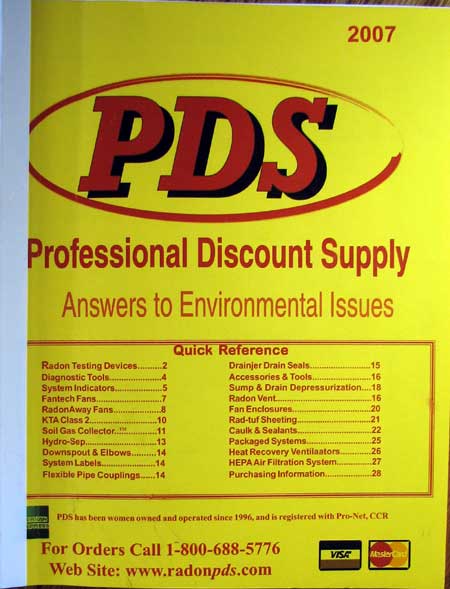
Some radon supplies that I would recommend purchasing from a radon supplier are:
Radon Barrier Cloth
On first comparison this cloth seems to be more expensive than good old plastic sheeting, but it has much better puncture resistance, will last much longer, is bright white and I think is worth the small cost it adds to the project.

Permathane Polyurethane Sealant
SM7108 sticks radon barrier cloth to concrete and to the cloth itself. It is flexible when dry, which cannot be said of all sealants. This is a necessary component when you want to be under your house once and once only. The possible drawback is the cost of shipping from Colorado. I am in the process of trying to get local supply houses to carry more radon products. Remember not to cover wood posts or sills to prevent termites from doing their work beneath the cover of the barrier cloth.
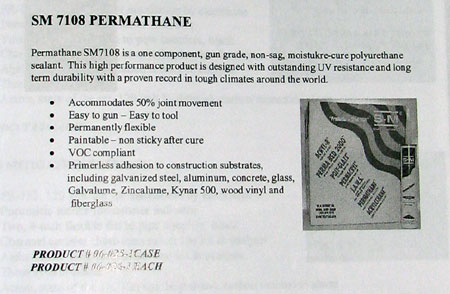
Possible alternative, but not recommended.

I have had one report from a customer in the summer of 2008 that PL300 Foam Board Adhesive made for Styrofoam boards, works well to stick plastic to concrete and to itself. One benefit is that it is available locally, at Home Depot and Lowes.
But caution, another customer had this to say as of 3/17/09: I am sending this info just to let you know of my experience with PL300. Monday I received my fan and accessories from PDS. So on Tuesday i was ready to go Home Depot to get the rest of the stuff. I did one more check of the sample polyethylene test strips with the PL300, poly to poly and poly to concrete. These samples were looking ok up thru Monday. When I checked them Tuesday morning, I was able to peal away the poly with very little force from all the samples. I used Husky(Home Depot) 4 mil and 6 mil clear, also Contractor's Choice(Lowes) 6 mil. All of these test strips were now questionable.
I went ahead and ordered the barrier material from PDS and one case of their sealant Permathane. Since the shipping alone was $100, I'll see if one of the locally available sealants will work with their barrier material as it is supposed to be oil free and I'll need more than one case. I even tried a sample cleaned with mineral spirits and one rubbed with steel wool with no improvement. So for now, I'll stick with the proven stuff , with a little more testing when I get the barrier material from PDS.
3. Adhesive and Barrier Cloth Adhesion Tests
Bill Brodhead, of WPB Enterprises, Inc. in Northeast Pennsylvania, has taken the time to research the adhesion quality of various adhesives to various barrier clothes. Check his report and
"Note that some adhesives work excellent for one type of membrane but have little holding power for another type of membrane."
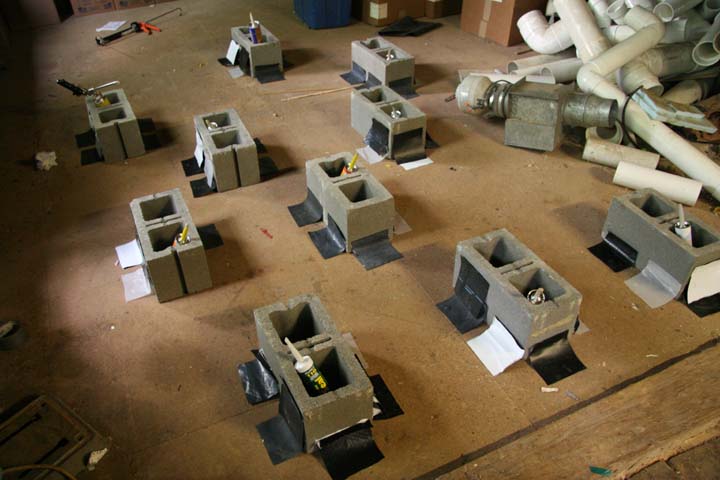
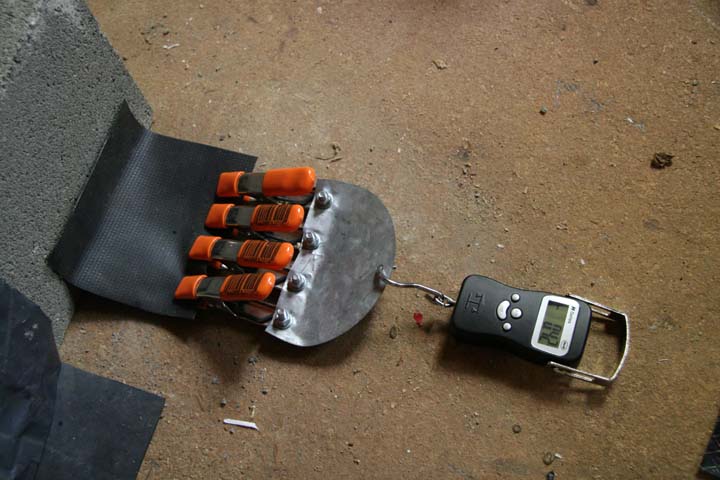
4. KTA Low Voltage Radon Fan
These fans plug into 110 receptacles and can be installed by the homeowner (Class 2 - 24 volt). I like the LV-2133 because if its super low power consumption (only 20 watts!) but the LV-150 is fine too if more suction power is needed. Radon fans are a must for doing the radon project right.

5. Some other supplies worth considering are:
Protecting Your Home from Radon - the Do-It-Yourself manual to insure the job is done right.
Available here.
Continuous Radon Monitor - Safety Siren
Available here.
Soil Gas Collector Matting for use under new concrete slabs.
Available from PDS.
4x3 inch Metal Downspout for use in venting the radon gas from the fan to above the roof. Can be purchased in Weatherguard colors to blend in with the house color and look more like rain gutter than a vent pipe.
Available from PDS.
Hydro-Sep Water Separator to release moisture from exterior mounted active radon mitigation systems. Water vapor in ground soil can condense on the cool vent pipe and drain back into the fan. This ingenious device allows the water to drip outside the pipe.
Available from PDS.
6. Radon mitigation installer Bill Brodhead (WPB Enterprises, Inc) has an excellent research paper on water bypass systems. Here are some pictures from WPB.
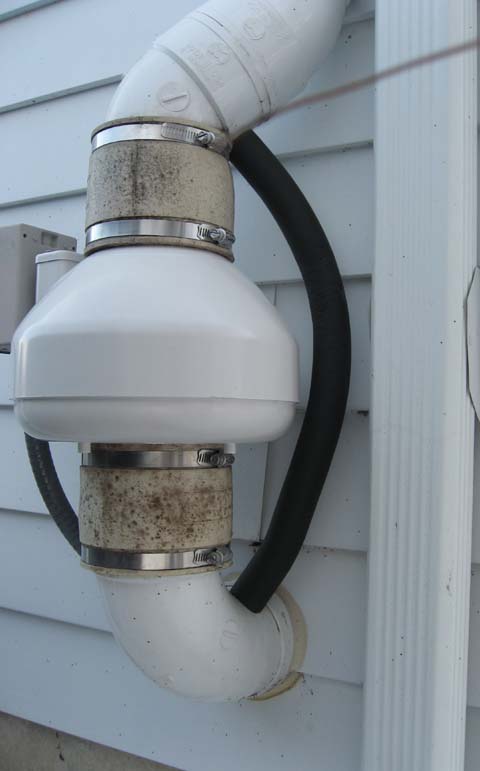
He also shows a detailed explanation with photos on how to install a water bypass system on his web site.
Here is a simple "T" drain setup that has potential for eliminating water and ice damage in cold climates. Bill tells me there is no radon blow-back through the drain hole, a slight problem with some of the other methods. Also the heat from the crawl space air and the fan prevent the hole from freezing in winter. I may change my setup to something like this one (someday!). We are always interested in new ways to push the envelope in developing the simplest, cheapest, most effective systems. 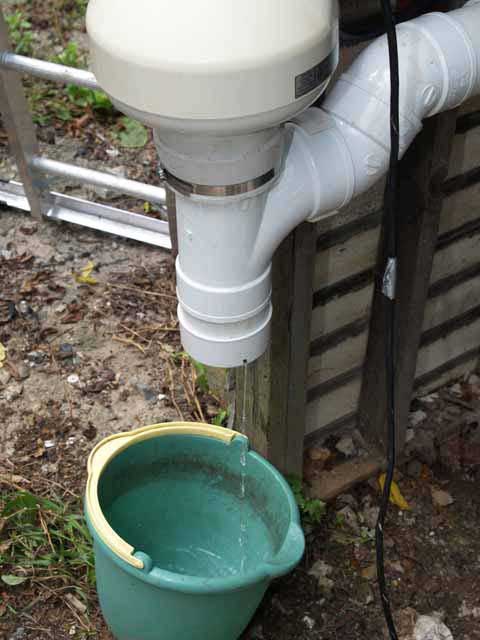
|